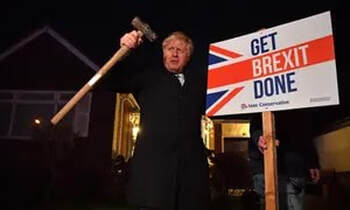|
After a stunning, landslide victory for Boris Johnson and his Conservative party in the 12 December UK general election, Britain is on course to leave the European Union on 31 January 2020. The British people have given Prime Minister Johnson a parliamentary majority of 80 seats and a clear mandate to “Get Brexit Done,” the slogan of his re-election campaign. All hopes for a last-ditch effort to keep the UK in or to have a second referendum have been dashed, but the Brexit process is far from over. Brexit will not be “done” on 31 January, in fact, the harder part may be yet to come. With the British departure all but assured for the end of January, what’s next for the trade relationship between the UK and the EU and how does this impact potential trade negotiations for a US-UK trade agreement? In this post, I try my best to answer these questions and to give more context on how Brexit could impact US exporters.  The Future UK-EU Trade Relationship Prime Minister Johnson will have no problem getting his Brexit deal through Parliament, but this is merely the terms of the divorce. The next phase of the Brexit negotiations will determine Britain’s future trading relationship with the European Union. The timing for these trade negotiations is key.[i] After Brexit day on 31 January, an 11-month transition period through 31 December 2020 will begin. During the transition, the UK remains in a customs union with the EU and duty-free trade will proceed unimpeded as if the UK were an EU member state. The UK can ask for an extension of up to two years to this transition, but it has to do so before 1 July. Prime Minister Johnson, in order to fulfill a campaign promise, is altering the Brexit Withdrawal Act to make it illegal to extend the transition period beyond the end of 2020.[ii] This leaves London only 11 months to negotiate an ambitious free trade agreement with Brussels that will maintain duty-free trade between the UK and the EU-27 member states. Analysts, diplomats in Brussels, and European heads of state have serious doubts that such a trade agreement can be completed in such a short period of time. Should the two sides not come to an agreement that is in force by 31 December 2020, the UK will crash out of the European Union on WTO Most Favored Nation (MFN) terms. Given the short timeline, we could see a phased approach that begins with a very limited trade deal in place by the end of 2020[iii], as German officials have already proposed.[iv] Prime Minister Johnson’s large parliamentary majority will allow him to pursue whatever trade relationship he likes, but what his vision entails remains to seen.[v] Whatever agreement is ultimately made, trade friction between the EU and UK will be unavoidable. The many US companies invested in the UK will find it more complicated and expensive to trade their goods into the EU-27 under even an ambitious FTA. Brussels has been adamant that a trade agreement can only be completed with a “level playing field” on both sides of the Channel on regulatory matters like labor, environment, health, product standards, and state aid. [vi] The EU’s primary goal of the Brexit negotiations thus far has been to protect the integrity of its most cherished accomplishment, the Single Market, and there is no incentive for the EU as the dominant party in the negotiations to be very flexible on regulatory issues. UK regulatory flexibility will come at the expense of greater market access to the EU. This is where the future EU-UK trade relationship is likely to impact the negotiations for a US-UK trade deal. A US-UK Trade Agreement? President Trump was quick to congratulate Prime Minister Johnson on his victory on Twitter and signaled that the result will allow the UK to negotiate a trade agreement with the US, “Britain and the United States will now be free to strike a massive new Trade Deal after BREXIT. This deal has the potential to be far bigger and more lucrative than any deal that could be made with the E.U.” A post-Brexit trade agreement with the US has been a key promise and talking point of Prime Minister Johnson and other Brexiteers throughout the Brexit process. The two sides can begin formal negotiations once Britain leaves the EU on 31 January. It is not hard to understand the logic behind a US-UK trade agreement. After all, the US is the single largest trading partner for the UK[vii], while the UK ranks 7th on the list of US trade partners in 2018.[viii] As the UK leaves the European Union, it makes sense for London to seek closer economic relations with one of its closest allies not to mention the world’s largest market. It sounds like a good opportunity for US exporters. However, there are reasons to be skeptical of the prospects for a “massive” US-UK trade deal. Washington will be the far more powerful party in negotiations with an economically weakened UK and will seek major concessions from London on non-tariff barriers and market access, especially in the agricultural sector as stated in the US negotiating objectives.[ix] UK consumers will be sensitive to opening up their markets to US ag products given that the UK as a member of the EU currently has higher standards for agriculture and food safety. This gets to the biggest challenge facing a US-UK trade deal: the scope of a US-UK trade agreement will depend on how far the UK is willing to deviate from EU regulations, and, in turn, how much EU market access the UK is willing to sacrifice. Diverging from EU regulations will be tough to do politically for Prime Minister Johnson. There are strong political economic incentives to remain more closely aligned with the EU regulatory regime. Even though the US is the UK’s single largest trading partner, UK trade with the US pales in comparison to its trade with the EU-27 taken as a whole. In 2018, 45% of UK exports went to the EU and 53% of imports into the UK came from the EU. Only 19% of British exports went to the US in the same year.[x] UK exporters will want to retain duty-free and frictionless trade with the EU, meaning a deep and comprehensive FTA with Brussels; but, the EU will only give such access if the UK maintains a “level playing field” on regulations. As a recent Ernst and Young publication puts it, “Aligning closer to the US would involve an inevitable trade-off with disentangling the UK from EU standards and in so doing enhance non-tariff barriers with the EU. All this points to some practical difficulties ahead in reaching a deal.”[xi] US exporters should be skeptical of the rhetoric coming from the White House and Downing Street. While an FTA will provide opportunities for US exporters who do business with the UK, the scope of that agreement will depend on Britain’s future trading relationship with Europe. That scope is likely to be more limited, if an agreement is reached at all, than what some in government on both sides of Atlantic are currently envisioning. US exporters should watch closely as the Brexit negotiations move to the second phase as they will indicate how the UK balances the trade-off between regulatory divergence and greater EU market access. Concluding Thoughts While there are strong political and economic arguments to be made that Britain should hitch its economy to the EU, that Brexit is happening in the first place suggests a certain willingness from the UK to reorient its commercial relations away from Europe. The Brexiteers have promised that a Britain unshackled from the EU will be a free trading nation and will sign trade deals with countries around the world. As Brexit moves from the withdrawal phase to the future relationship phase, economics and trade will feature more prominently in the national debate. Prime Minister Johnson and his Government will finally have to confront the economic realities that a closer trade relationship with the EU is in the UK’s best interest, and they will now own the economic and political consequences of their choices. We would love to hear from you. Send us your thoughts on Brexit by commenting below or via LinkedIn or Twitter. Happy Holidays! Scott McCallum [email protected] (+1) 240.389.9003 References [i] Sloat, Amanda, “Brexit endgame: British voters back Boris and Brexit,” Brookings (13 December 2019). [ii] “Brexit bill to rule out extension to transition period,” BBC News (17 December 2019). [iii] O’Carroll, Lisa, “What Johnson has to drop to get a quick trade deal after Brexit,” The Guardian (17 December 2019) [iv] Bayer, Lili and Hans Von Der Burchard, “Berlin says a ‘standard’ EU-UK trade deal can be done in 2020,” Politico (11 December 2019). [v] Menon, Anand, “What will Boris Johnson's majority mean for Brexit?,” The Guardian (12 December 2019). [vi] Bayer, Lili, David M. Herszenhorn, and Maïa de la Baume, “After Tory election romp, EU adopts new Brexit slogan,” Politico (16 December 2019). [vii] Ward, Matthew, “House of Commons Briefing Paper: Statistics on UK-EU Trade,” House of Commons Library (16 December 2019). [viii] “Top Trading Partners December 2018 Year-to-Date,” United States Census Bureau. [ix] “United States-United Kingdom Negotiations: Summary of Specific Negotiating Objectives,” Office of the United States Trade Representative (February 2019). [x] Ward, Matthew, “House of Commons Briefing Paper: Statistics on UK-EU Trade,” House of Commons Library (16 December 2019). [xi] “UK and US trade: Prospects for a free trade deal,” Ernst and Young (June 2019). Comments are closed.
|
|





